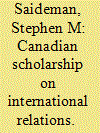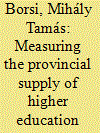|
|
|
Sort Order |
|
|
|
Items / Page
|
|
|
|
|
|
|
| Srl | Item |
| 1 |
ID:
146485


|
|
|
|
|
| Summary/Abstract |
This article examines the Canadian data collected by the Teaching, Research and International Policy project to assess the state of Canadian international relations scholarship. The focus is on the divide, mentioned but not studied in previous work, between the higher profile PhD programs (UBC, McGill, Toronto) and other Canadian universities. The results indicate that the approaches, methods, and theoretical inclinations differ less than often averred, but that the two groups do value different scholars, journals, and presses. And there is more diversity within each side than often argued, which makes the divide itself less deep. The article concludes with some implications about the possibility of a distinctively Canadian international relations.
|
|
|
|
|
|
|
|
|
|
|
|
|
|
|
|
| 2 |
ID:
187823


|
|
|
|
|
| Summary/Abstract |
This paper proposes and estimates three novel higher education indices for 31 Chinese provinces: i) the Chinese Higher Education Density Index (CHEDI) to analyze the evolution of the quantitative distribution of higher education institutions (HEIs) in each province from 2001 to 2017, which is further decomposed into subgroups based on the type of college, i.e., four-year undergraduate colleges, two-year vocational colleges, and private institutions; ii) the Chinese Higher Education Quality Index (CHEQI) to examine the supply of higher education in terms of quality using a university ranking system; and iii) the Chinese Higher Education Index (CHEI), a composite indicator that incorporates both the quantity and quality dimensions of higher education institutions for each province, providing a weighted measure of the supply of higher education in China. The empirical findings indicate a significant and persistent heterogeneity in the supply of higher education between provinces. The indices identify which regions have been substantially rewarded by the higher education expansion of recent decades, going from an undersupply to a proportionate supply of higher education institutions. On the other hand, a significant share of regions still has a low supply in terms of either the quantity or quality of HEIs, or both.
|
|
|
|
|
|
|
|
|
|
|
|
|
|
|
|
| 3 |
ID:
168200


|
|
|
|
|
| Summary/Abstract |
We argue that the World Bank has successfully marshaled the Ease of Doing Business (EDB) Index to amass considerable influence over business regulations worldwide. The Ease of Doing is a global performance indicator (GPI), and GPIs—especially those that rate and rank states against one another—are intended to package information to influence the views of an audience important to the target, such as foreign investors or voters, thus generating pressures that induce a change in the target's behavior. The World Bank has succeeded in shaping the global regulatory environment even though the bank has no explicit mandate over regulatory policy and despite questions about EDB accuracy and required policy tradeoffs. We show that the EDB has a dominating market share among business climate indicators. We then use media analyses and observational data to show that EDB has motivated state regulatory shifts. States respond to being publicly ranked and some restructure bureaucracies accordingly. Next we explore plausible influence channels for the EDB ranking and use an experiment involving US portfolio managers to build on existing economics research and examine whether the rankings influence investor sentiment within the experiment. Using a case study of India's multiyear interagency effort to rise in the EDB rankings, as well as its decision to create subnational EDB rankings, we bring the strands of the argument together by showing how politicians see the ranking as affecting domestic politics, altering investor sentiment, and engaging bureaucratic reputation. Overall, a wide variety of evidence converges to illustrate the pressures through which the World Bank has used state rankings to achieve its vision of regulatory reform.
|
|
|
|
|
|
|
|
|
|
|
|
|
|
|
|
| 4 |
ID:
101158


|
|
|
|
|
| Publication |
2010.
|
| Summary/Abstract |
This paper ranks the economic research institutions in China based on publications in the SSCI economics journals from 2000 through 2009 and finds that the gap in the research capacity of economic research institutions between the mainland and Hong Kong is very large, even though the difference in overall quality is not so significant. This paper can reflect successes and failures of the reform of the economics education in China over the past decade and give important implications for the ongoing reforms as well.
|
|
|
|
|
|
|
|
|
|
|
|
|
|
|
|
|
|
|
|
|